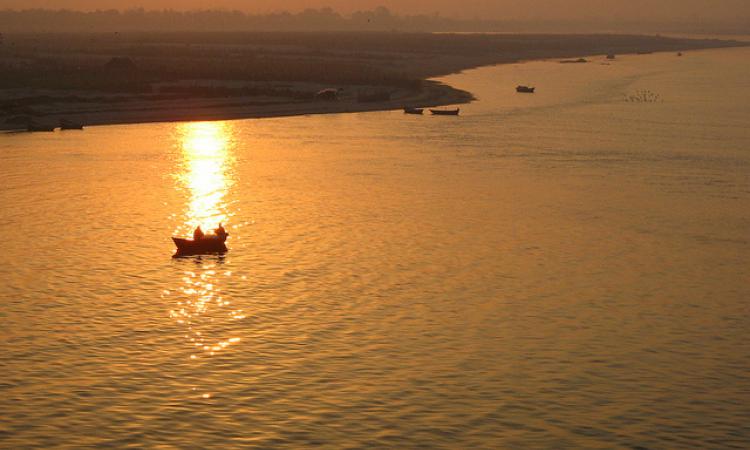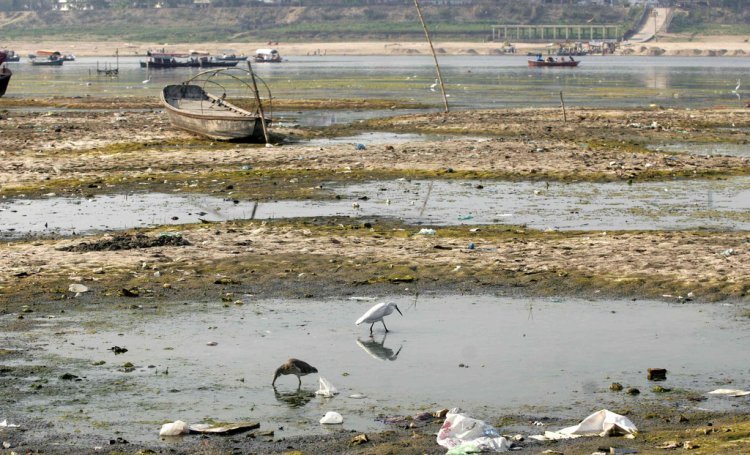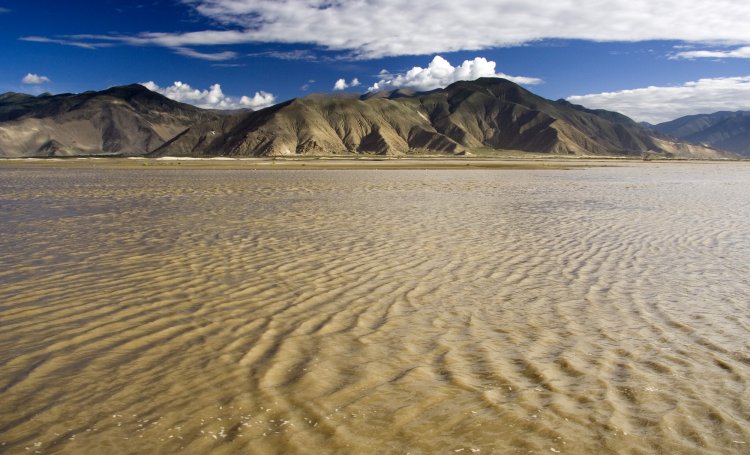
Government allocated Rs 4,173 crore for Water Resources and of this, Namami Gange received Rs 2,037 crore. Later, in addition to this, the Centre also approved Rs 20,000 crore for Ganga rejuvenation over the next five years.
One of the not-so new government's main agendas in 2015 was to have cleaner rivers in the country, and what better way to start than with the Ganga. With Namami Gange becoming a pet project of the Modi Government, hopes arose for a cleaner Ganga. Not just the Ganga but all the rivers in the country (including the mythical Saraswati river) received the attention of authorities either at the central or state level. It was about time too as a report revealed that 80% of India's surface water is polluted and that the polluted river stretches in the country rose from 22 in 1989 to 302 this year. The Central Pollution Control Board (CPCB) was blamed for not effectively executing clean up measures despite spending so much money. A CPCB report itself revealed that the water quality of 40 important rivers at interstate borders was poor.
The waters of many rivers were declared as unfit for human consumption. This included rivers in Goa with fecal coliform bacteria, and rivers in Karnataka where none were suitable for drinking. In Uttar Pradesh, the Kali, Krishna and Hindon river waters were poisonous as they were flooded with heavy metals but pollution was just one factor affecting rivers. The other important factor was the number of hydropower power projects which continue to choke rivers such as the Chenab in Jammu & Kashmir.
Amidst such gloom, here is a recap of important news related to some of the major rivers this year.
The Ganga
Steps to curb pollution
 Earlier this year, the centre and the states where the Ganga flows geared up for the ‘Clean Ganga Mission' with Jharkhand becoming the model state for the drive. The Uttar Pradesh Pollution Control Board initiated the process of closing 98 factories in Kanpur for polluting the Ganga while the National Green Tribunal revised its guidelines to identify seriously polluting units along the river in addition to grossly polluting ones, which are scrutinised by both the Central and State Pollution Control Boards. Also, the CPCB ordered some 3900 highly polluting industrial units along the river to install 24x7 online monitoring devices, out of which nearly 66% have complied to the orders while the remaining have been warned of strict action for non compliance.
Earlier this year, the centre and the states where the Ganga flows geared up for the ‘Clean Ganga Mission' with Jharkhand becoming the model state for the drive. The Uttar Pradesh Pollution Control Board initiated the process of closing 98 factories in Kanpur for polluting the Ganga while the National Green Tribunal revised its guidelines to identify seriously polluting units along the river in addition to grossly polluting ones, which are scrutinised by both the Central and State Pollution Control Boards. Also, the CPCB ordered some 3900 highly polluting industrial units along the river to install 24x7 online monitoring devices, out of which nearly 66% have complied to the orders while the remaining have been warned of strict action for non compliance.
In March, the National Mission for Clean Ganga served notice to 118 local bodies and 764 units for polluting the river but later, the Nirmal Ganga Sahbhagita scheme was launched to develop a sustainable partnership with these 118 Urban Local Bodies. Recently, the Government has decided not to allow new constructions on the Ganga or any of its tributaries in order to maintain the river’s minimum environmental flow and protect the ecology dependent on it. Also, plastic has been completely banned from Gomukh to Haridwar along the stretch of the Ganga.
Smart Ganga clean-up
To involve the public in the Clean Ganga Mission, the Water Ministry launched the Bhuvan Ganga Mobile Application and web portal. The app enables people to click and upload pictures of pollution sources so that further action can be taken.
The revival
India, inspired by the revival of the Rhine river, hopes to apply a similar success model to the Ganga. Also, Prime Minister Narendra Modi has called for an 'uncompromising mission mode approach' to revive the river. Recently, the CPCB has also proposed a segment-wise cleaning of the river based on geography, eco-flow of the river and pollution load. The demarcated segments are Gomukh to Haridwar, Haridwar to Narora, Narora to Varanasi and Varanasi to Kolkata. The Government has also committed to completing the Ganga Rejuvenation project by 2018.
Some good news
- Ganga shifts to original course in Patna: In March, the High Court ordered the Central and Bihar Governments to restore the Ganga's original course, which had shifted northward from Patna by about 2-3 km in the last two decades. Per the records of Bihar State Pollution Control Board (BSPCB), it was the brick kilns--nearly 596 in numbers--along the banks of the Ganga that were to be blamed for the shift. However, by the efforts of the Bihar Government, the original course of the river has been partly brought back with a stream now flowing across the banks in Patna.
- Rise in the number of Gangetic dolphins in UP: The Worldwide Fund for Nature (WWF) India conducted a dolphin census in Ganga and its tributaries this year. With 1,263 Gangetic dolphins in Uttar Pradesh, the number of the National Aquatic Animal in the state has increased from 671 dolphins, which was counted in the last survey conducted in 2012. The dolphin will soon have a reserve of its own in the Ganga.
- Study on Ganga’s origin and medicinal value: While the National Institute of Hydrology (NIH) will investigate if the origin of the Ganga river is the Mansarovar lake in Kailash instead of Gaumukh near Gangotri, the Health Ministry will take up a study to explore the medicinal properties of the Ganga.
The Yamuna
The Government plans to generate Rs 4500 crore for Yamuna clean-up through the Environmental Compensation Fee.
Earlier this year, the Central Water Commission had mentioned in its report that the water of the Yamuna is polluted beyond repair and that it is unfit for both irrigation and drinking purposes. Following the report, authorities took several stern actions like ordering 67 factories discharging hazardous effluents directly in the river in Mathura to shift and putting a ban on cultivating edible crops in the floodplains of the Yamuna in Delhi. The NGT also announced a fine ranging from Rs 5000-50,000 for anyone found throwing waste or religious offerings into the Yamuna in Delhi. Along with this, the NGT also warned Delhi Authorities of taking 'coercive steps' against them if the latter failed to implement its orders towards the 'Maili se Nirmal Yamuna Revitalisation Project 2017'. Moreover, the Tribunal has also decided to levy environmental compensation of Rs 100-500 on every household for polluting the river. Recently, the Government has launched a 'Yamuna Aarti' program in a bid to clean the river and promote tourism.
The Brahmaputra

In October, China operationalised the 510 MW Zangmu Hydropower Project, one of the biggest dams on the Brahmaputra. This is a big concern for India as it might have a possible impact on the Upper Siang and Lower Subansiri projects in Arunachal Pradesh. However, the Chinese Government has assured India that the massive project will not affect the environment or water flows in downstream areas. But to further increase India's worries, China has approved the construction of three more dams on the river. Not just this but the latter is also planning to exploit its source in the Himalayan glaciers as it has aimed to build 5 million cubic metres of bottled water production capacity.
The Saraswati
The Rajasthan and Haryana Governments have decided to revive the mythical Saraswati river for which the former appointed the Rajasthan River Basin and Water Resources Planning Authority while the latter constituted the Haryana Saraswati Heritage Development Board. WAPCOS has also been appointed for technical help and will help in the alignment of water channels as well as the construction of reservoirs and dams. The plan is to extract water from paleo channels of the mythological Saraswati after digging borewells of 1,000 metres depth. The total cost of the project has been estimated to be Rs 70 crore. However, no signs of water from the river have been observed as yet and the Government is looking for the possibility of channelising water from other sources into the believed path of the Saraswati.
Interlinking of rivers
Mostly all the states in the country are in favor of interlinking rivers, except for Odisha and Kerala. However, the Centre has taken up the exercise to convince the two States about the benefits of interlinking.
- Godavari-Krishna interlinked: On September 9, 2015, now a historic date for Andhra Pradesh, water from the Godavari reached the Polavaram canal in the Krishna Delta region after flowing for 124 km. However, leakages were observed in the project a week after it was commissioned.
- Ken-Betwa river link receives opposition: Despite opposition, the Government is determined to link the Ken-Betwa rivers. The project is getting clearance after clearance from the Centre and the Madhya Pradesh Authorities, even though activists have highlighted the significant impacts the project will pose on the Panna Tiger Reserve. Along with the tiger reserve, the project will also submerge 60% habitat of vultures.
Other major news
- Identification and Cabinet approval to declare 106 additional inland waterways as National waterways
- Water Ministry ordering the Central Water Commission not to grant approval to any dam project until the e-flow report is out
- The Indus river which shifted its course in 1819, re-entering India and feeding the Nal Sarovar in Gujarat
- The Maharashtra Government deciding to scrap the State's River Zone Regulation policy; however, the decision was later questioned by the NGT
We hope that 2016 will be a more promising year for Indian rivers!